- Accueil
- Pages cachées
- 03 JANVIER 2024 NEWS
03 JANVIER 2024 NEWS
INSTITUT SUPERIEUR D'ANTHROPOLOGIE
INSTITUT OF ANTHROPOLOGY
COURS ONLINE – COURS A DISTANCE
ANNEE 2024-2025 INSCRIPTIONS OUVERTES
REGISTER NOW
EGYPTE – 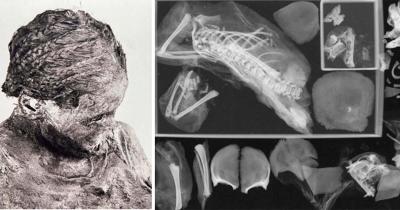
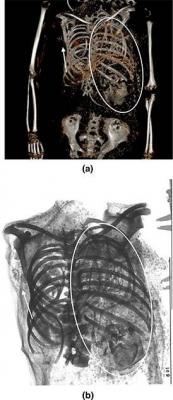 El Bagawat - Archaeologists have made a shocking discovery after re-examining the mummified remains of a teen mom aged just 14-17 who died in childbirth more than 1,500 years ago. What makes the find both horrifying and extraordinary at the same time, is one fetus and placenta found in the pelvic area, and another in the chest. Researchers analyzed the mummified remains of a teenage girl who died during childbirth in ancient Egypt, revealing that the young mother-to-be was in the process of delivering twins when she died. Unfortunately, the labor took a negative turn when the first baby’s head became stuck in the birth canal, resulting in the deaths of both infants and the mother. In Egypt’s Kharga Oasis, the teen mom was discovered in 1908 at the El Bagawat cemetery. The researchers noted that she had been extensively layered with “a great quantity of salt,” an ancient Egyptian practice known for its desiccating properties that effectively dried out the entire body. The body was dated to the Late Dynasty in ancient Egyptian history, spanning from 404 to 343 BC. Field notes from the time reveal that she was found with a fetus and placenta between her legs, leading to the conclusion that she had died from obstetric complications. Using computed tomography (CT) scans of the body, the George Washington University team revisited the mummy after over a century to ascertain precisely what might have gone wrong. The scans revealed the presence of a second fetus within the woman’s chest cavity, indicating that she was carrying twins. More startling revelations were to come when the researchers noted that the infant placed between the woman’s legs was missing its head. Upon closer examination, they realized that the baby’s head was still lodged in the mother’s pelvis, leading them to suspect that the fetus had become decapitated during the birthing process. The study authors describe this outcome as a case of “traumatic fetal decapitation,” a rare consequence of breech presentations, i.e., feet first during childbirth. “This is a rare find,” Francine Margolis, one of the study authors, told McClatchy News. “There are several examples of women dying during childbirth in the archaeological record (one was a twin pregnancy). However, there has never been one found in Egypt.”The second fetus discovered in the woman’s chest cavity raised some mystery. According to the researchers, it’s possible that the embalmers were not aware of the twin pregnancy and forgot to remove the second fetus before mummification. According to IFL Science, the unborn twin may have moved from the womb to the chest cavity as the mummy’s diaphragm dissolved. “This examination of the mother and her children at birth reconfirms how dangerous pregnancy, labor, and delivery was, especially during this time period,” write the study authors. The ancient Egyptians held a deep reverence for symbolism, balance, and order, and these beliefs extended to their views on procreation and childbirth. A spell found on ancient papyrus, the Oracular Amuletic Decree, said, “We shall (cause her) toconceive male children and female children. We shall keep her safe from a Horus-birth, from an irregular birth and from giving birth to twins.” Spells and incantations like this one reveal a cultural aversion to twin births, seeking protection from “irregular birth” and giving birth to twins. The tragic story of this young mother and her unborn twins is a tragic reminder of the difficulties that ancient women faced during childbirth. The study – including images of the mummy – is published in the International Journal of Osteoarchaeology.
El Bagawat - Archaeologists have made a shocking discovery after re-examining the mummified remains of a teen mom aged just 14-17 who died in childbirth more than 1,500 years ago. What makes the find both horrifying and extraordinary at the same time, is one fetus and placenta found in the pelvic area, and another in the chest. Researchers analyzed the mummified remains of a teenage girl who died during childbirth in ancient Egypt, revealing that the young mother-to-be was in the process of delivering twins when she died. Unfortunately, the labor took a negative turn when the first baby’s head became stuck in the birth canal, resulting in the deaths of both infants and the mother. In Egypt’s Kharga Oasis, the teen mom was discovered in 1908 at the El Bagawat cemetery. The researchers noted that she had been extensively layered with “a great quantity of salt,” an ancient Egyptian practice known for its desiccating properties that effectively dried out the entire body. The body was dated to the Late Dynasty in ancient Egyptian history, spanning from 404 to 343 BC. Field notes from the time reveal that she was found with a fetus and placenta between her legs, leading to the conclusion that she had died from obstetric complications. Using computed tomography (CT) scans of the body, the George Washington University team revisited the mummy after over a century to ascertain precisely what might have gone wrong. The scans revealed the presence of a second fetus within the woman’s chest cavity, indicating that she was carrying twins. More startling revelations were to come when the researchers noted that the infant placed between the woman’s legs was missing its head. Upon closer examination, they realized that the baby’s head was still lodged in the mother’s pelvis, leading them to suspect that the fetus had become decapitated during the birthing process. The study authors describe this outcome as a case of “traumatic fetal decapitation,” a rare consequence of breech presentations, i.e., feet first during childbirth. “This is a rare find,” Francine Margolis, one of the study authors, told McClatchy News. “There are several examples of women dying during childbirth in the archaeological record (one was a twin pregnancy). However, there has never been one found in Egypt.”The second fetus discovered in the woman’s chest cavity raised some mystery. According to the researchers, it’s possible that the embalmers were not aware of the twin pregnancy and forgot to remove the second fetus before mummification. According to IFL Science, the unborn twin may have moved from the womb to the chest cavity as the mummy’s diaphragm dissolved. “This examination of the mother and her children at birth reconfirms how dangerous pregnancy, labor, and delivery was, especially during this time period,” write the study authors. The ancient Egyptians held a deep reverence for symbolism, balance, and order, and these beliefs extended to their views on procreation and childbirth. A spell found on ancient papyrus, the Oracular Amuletic Decree, said, “We shall (cause her) toconceive male children and female children. We shall keep her safe from a Horus-birth, from an irregular birth and from giving birth to twins.” Spells and incantations like this one reveal a cultural aversion to twin births, seeking protection from “irregular birth” and giving birth to twins. The tragic story of this young mother and her unborn twins is a tragic reminder of the difficulties that ancient women faced during childbirth. The study – including images of the mummy – is published in the International Journal of Osteoarchaeology.
TURQUE –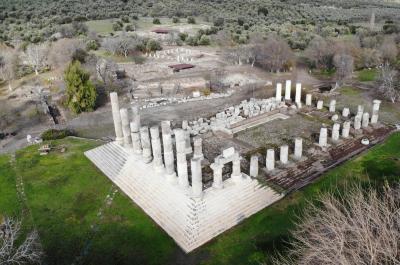
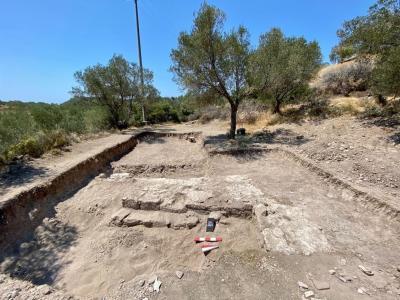 Gülpınar – A 2,000-year-old monumental tomb dating back to the Roman Empire period was discovered in the necropolis (cemetery) adjacent to the northwest of Apollon Smintheus Sanctuary (Smintheion), located in the town of Gülpınar, Çanakkale. Initial assessments of the skeletons found within the burial chamber inside the vessel revealed that more than 10 individuals, including children and adults, were interred in this tomb, their remains disturbed and mixed. Researchers suggest that this tomb might have been commissioned by affluent individuals due to its plan, indicating the existence of monumental tombs during the Roman Imperial period at Smintheion. The excavation, which began on June 15, was concluded this year on Oct. 1. The concentration was in the necropolis (cemetery) situated to the northwest of the Apollon Smintheus Temple. Excavations at three different points revealed remnants of two tombs alongside foundational remains of some structures. Hüseyin Yaman, a member of the excavation team said: "We aim not only to acquire information about the burial traditions of individuals and communities that once existed here but also to contribute to the delineation of the distribution area of sacred structures, or in other words, to determine the boundaries of the sacred area. In line with this goal, in the excavations conducted at three different points, we revealed remnants of two tombs alongside foundational remains of some structures. Based on the artifacts found in the only room that seemed to have survived with intact foundations in the monumental tomb, we estimate its origin to be approximately 2,000 years ago, around the first century A.D." Highlighting the new findings obtained in the necropolis after the excavation in the early 1990s, Yaman emphasized the discovery of some walls belonging to the Late Roman period, as well as a section of a stone-paved courtyard or dead-end street and a small, round-shaped structure resembling a pool. "The round-shaped structure, with its lime-plastered base, is initially interpreted as part of a workshop. Geophysical surveys were conducted alongside excavations at three openings and initial results indicated the presence of different spaces. The work will continue in the upcoming years. With the potential emergence of more tombs in this area, along with an increase in the number of other spaces, we will be able to obtain much more comprehensive information about burial traditions, types of tombs, changes in the boundaries of the sacred area and architectural phases," he remarked.
Gülpınar – A 2,000-year-old monumental tomb dating back to the Roman Empire period was discovered in the necropolis (cemetery) adjacent to the northwest of Apollon Smintheus Sanctuary (Smintheion), located in the town of Gülpınar, Çanakkale. Initial assessments of the skeletons found within the burial chamber inside the vessel revealed that more than 10 individuals, including children and adults, were interred in this tomb, their remains disturbed and mixed. Researchers suggest that this tomb might have been commissioned by affluent individuals due to its plan, indicating the existence of monumental tombs during the Roman Imperial period at Smintheion. The excavation, which began on June 15, was concluded this year on Oct. 1. The concentration was in the necropolis (cemetery) situated to the northwest of the Apollon Smintheus Temple. Excavations at three different points revealed remnants of two tombs alongside foundational remains of some structures. Hüseyin Yaman, a member of the excavation team said: "We aim not only to acquire information about the burial traditions of individuals and communities that once existed here but also to contribute to the delineation of the distribution area of sacred structures, or in other words, to determine the boundaries of the sacred area. In line with this goal, in the excavations conducted at three different points, we revealed remnants of two tombs alongside foundational remains of some structures. Based on the artifacts found in the only room that seemed to have survived with intact foundations in the monumental tomb, we estimate its origin to be approximately 2,000 years ago, around the first century A.D." Highlighting the new findings obtained in the necropolis after the excavation in the early 1990s, Yaman emphasized the discovery of some walls belonging to the Late Roman period, as well as a section of a stone-paved courtyard or dead-end street and a small, round-shaped structure resembling a pool. "The round-shaped structure, with its lime-plastered base, is initially interpreted as part of a workshop. Geophysical surveys were conducted alongside excavations at three openings and initial results indicated the presence of different spaces. The work will continue in the upcoming years. With the potential emergence of more tombs in this area, along with an increase in the number of other spaces, we will be able to obtain much more comprehensive information about burial traditions, types of tombs, changes in the boundaries of the sacred area and architectural phases," he remarked.
Roman tomb discovered in Apollon Smintheus Sanctuary in Türkiye | Daily Sabah
MEXIQUE 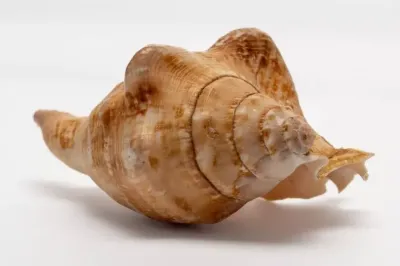 Telchac Pueblo - Excavations at a site in Telchac Pueblo have revealed several pre-Hispanic structures scattered over an area of more than 23 hectares (57 acres). The structures included "unusual mounds of Earth" that were found to be full of ash and charcoal, one of the archaeologists, Mario Alberto Garrido, told EFE. There are no registered archaeological sites near the area, which is why the discovery of the structures is "very important" for the archeology of the region, Garrido said. In addition to the structures, the researchers found more than 100 fragments of ancient pottery. Most of the ceramics date to the Early Classic period of Mesoamerican history (A.D. 250-600), although a small proportion date to the Late Preclassic period (400 B.C.-A.D. 200), according to the researchers. The site of the camp is in "the middle of nowhere" and difficult to reach, Garrido told EFE. It is likely that the Maya used the camp only during the dry season, according to the researchers. The archaeologists also found the remains of a "large number of snails" in the area, Alicia Beatriz Quintal, a researcher with Mexico's National Institute of Anthropology and History, told EFE. The remains include complete snail shells that had been modified as well as many fragments. The Maya took advantage of the snails to feed themselves and make utensils such as spoons, according to the researchers. Although the ancient economy of the ancient Maya civilization in this region was principally based on the cultivation of staples such as maize, beans and squash, there is evidence that they were also proficient fishers, hunters and gatherers. For example, some previous research has shown that the Maya exploited freshwater snails from the genus Pachychilus. These mollusks were not only eaten but have also occasionally been found in Maya ritual deposits, according to a study published in the journal Latin American Antiquity.
Telchac Pueblo - Excavations at a site in Telchac Pueblo have revealed several pre-Hispanic structures scattered over an area of more than 23 hectares (57 acres). The structures included "unusual mounds of Earth" that were found to be full of ash and charcoal, one of the archaeologists, Mario Alberto Garrido, told EFE. There are no registered archaeological sites near the area, which is why the discovery of the structures is "very important" for the archeology of the region, Garrido said. In addition to the structures, the researchers found more than 100 fragments of ancient pottery. Most of the ceramics date to the Early Classic period of Mesoamerican history (A.D. 250-600), although a small proportion date to the Late Preclassic period (400 B.C.-A.D. 200), according to the researchers. The site of the camp is in "the middle of nowhere" and difficult to reach, Garrido told EFE. It is likely that the Maya used the camp only during the dry season, according to the researchers. The archaeologists also found the remains of a "large number of snails" in the area, Alicia Beatriz Quintal, a researcher with Mexico's National Institute of Anthropology and History, told EFE. The remains include complete snail shells that had been modified as well as many fragments. The Maya took advantage of the snails to feed themselves and make utensils such as spoons, according to the researchers. Although the ancient economy of the ancient Maya civilization in this region was principally based on the cultivation of staples such as maize, beans and squash, there is evidence that they were also proficient fishers, hunters and gatherers. For example, some previous research has shown that the Maya exploited freshwater snails from the genus Pachychilus. These mollusks were not only eaten but have also occasionally been found in Maya ritual deposits, according to a study published in the journal Latin American Antiquity.
Archaeologists Discover Ancient Camp Where Maya Ate Cooked Snails (newsweek.com)
TAJIKISTAN – 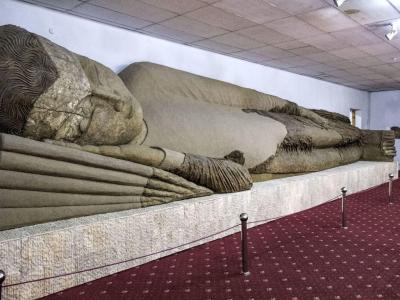 Dushanbe - In the past, while Taliban soldiers in Afghanistan destroyed two immense statues of Buddha, art historians in neighboring Tajikistan meticulously restored a huge reclining Buddha from the same period. The world’s largest “Buddha in Nirvana.” The terra-cotta figure, found in the 1960s among the ruins of a temple in southern Tajikistan, depicts a reclining Buddha, one hand resting on his hip, the other on a pile of pillows. Soviet archaeologists discovered the Buddha in the temple at the ruins of Adjina-Tepa, on a wind-swept field 50 miles north of the Afghan border. Known as Buddha in Nirvana, it was created in the sixth or seventh century and is believed to be a relic from the time when Buddhism ruled over the high mountains and deep valleys of Central Asia and Afghanistan before the advent of Islam. Like its Afghan cousins, Tajikistan’s Buddha is huge: 42 feet long and 9 feet high. The statue is housed in a hall that is a replica of the room in a Buddhist monastery where the Buddha was once kept, visited by worshipers who entered the room, walked past the statue, and walked out. For more than 30 years after its discovery, the statue was kept in three separate pieces in the storage rooms of the Tajik Museum of Architecture and History because there was no money to restore it.
Dushanbe - In the past, while Taliban soldiers in Afghanistan destroyed two immense statues of Buddha, art historians in neighboring Tajikistan meticulously restored a huge reclining Buddha from the same period. The world’s largest “Buddha in Nirvana.” The terra-cotta figure, found in the 1960s among the ruins of a temple in southern Tajikistan, depicts a reclining Buddha, one hand resting on his hip, the other on a pile of pillows. Soviet archaeologists discovered the Buddha in the temple at the ruins of Adjina-Tepa, on a wind-swept field 50 miles north of the Afghan border. Known as Buddha in Nirvana, it was created in the sixth or seventh century and is believed to be a relic from the time when Buddhism ruled over the high mountains and deep valleys of Central Asia and Afghanistan before the advent of Islam. Like its Afghan cousins, Tajikistan’s Buddha is huge: 42 feet long and 9 feet high. The statue is housed in a hall that is a replica of the room in a Buddhist monastery where the Buddha was once kept, visited by worshipers who entered the room, walked past the statue, and walked out. For more than 30 years after its discovery, the statue was kept in three separate pieces in the storage rooms of the Tajik Museum of Architecture and History because there was no money to restore it.
Tajik Buddha in Nirvana - the Largest in the World: 42 feet long and 9 feet high - Arkeonews
LIBYE – 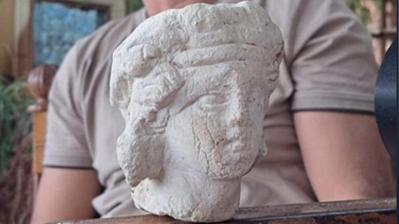 Cyrene - Libyan Archeology researcher, Issam Menfi found the head of the statue of Bacchus, which dates back to the Greek era, inside a water channel near the ancient city of Cyrene. The third artifact discovered as a result of storm “Daniel” that hit the eastern region last September, according to the Libyan News Agency, was saved by Menfi for scientific purposes. The agency further stated that the head of the statue is that of the figure “Bacchus,” also known as “Dionysus” and “Bacchus” in the Roman era, who is their god of wine. It was given to the Cyrene Antiquities Control Authority. Bacchus was the god of agriculture and wine, but he was also linked to fertility, drama, and revelry. In regards to agriculture, he was depicted as a god of trees and forest, and was often sought ought to help the orchards grow.
Cyrene - Libyan Archeology researcher, Issam Menfi found the head of the statue of Bacchus, which dates back to the Greek era, inside a water channel near the ancient city of Cyrene. The third artifact discovered as a result of storm “Daniel” that hit the eastern region last September, according to the Libyan News Agency, was saved by Menfi for scientific purposes. The agency further stated that the head of the statue is that of the figure “Bacchus,” also known as “Dionysus” and “Bacchus” in the Roman era, who is their god of wine. It was given to the Cyrene Antiquities Control Authority. Bacchus was the god of agriculture and wine, but he was also linked to fertility, drama, and revelry. In regards to agriculture, he was depicted as a god of trees and forest, and was often sought ought to help the orchards grow.
PALESTINE – Gaza - The Israeli army has destroyed more than 200 archeological and ancient sites out of 325 that were registered on the Gaza Strip. Anadolu News Agency quoted the Government Media Office in Gaza as saying that the sites include ancient churches, mosques, schools, museums and other different historical and archeological sites and monuments. “The ancient and archeological sites destroyed by the army date back to the Phoenician and Roman ages, others date back between 800 BC and 1,400, while others were built 400 years ago,” the Office said in a statement. The Great Omari Mosque, the Byzantine church in Jabaliya, the Shrine of Al-Khadir in Deir al-Balah city in central Gaza Strip, and the Blakhiya Byzantine cemetery (The Anthedon of Palestine), northwestern Gaza City were among the sites. The statement noted that other sites were severely damaged, including the Greek Orthodox Saint Porphyrius Church, the 400-year-old Al-Saqqa House and the Sayed al-Hashim Mosque, which is one of the oldest mosques in Gaza. The Geneva-based rights group, Euro-Med Monitor, said on November 20 that Israel deliberately destroyed archeological and historical monuments in the Gaza Strip, and accused it of “explicitly targeting Palestinian cultural heritage.” Gaza is rich in history. “Evidence of Hyksos, Roman, Byzantine, Islamic and other civilizations which dwelled in that region for thousands of years, is a testimony to the historical significance of the area,” Palestinian journalist and author Ramzy Baroud wrote in a recent article.
Israeli Forces Destroyed over 200 Archeological Sites in Gaza - Reports - Palestine Chronicle
CHINE – 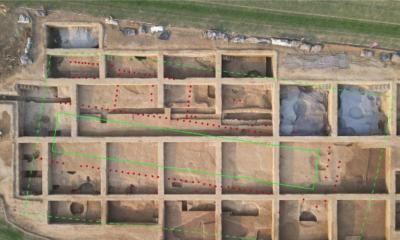 Xinmi - In Xinmi, in the Henan Province of Central China, a four-courtyard style palace complex from the Xia Dynasty (2070BC–1600BC), China’s earliest known dynasty, has been discovered. The Guchengzhai site, located on a plateau east of the Zhen River in Xinmi, spans a total of over 176,000 square meters, according to state-run news agency Xinhua. From 2021 to 2023, staff from the Henan Provincial Institute of Cultural Relics and Archaeology conducted systematic surveys and targeted excavations in both the inner and key outer areas of the site, yielding a series of significant achievements. The two sites, the Zhuqiu Temple site in the city of Zhoukou and the ancient walled city at Xinmi are believed to have been built in the Xia Dynasty (2070 B.C.-1600 B.C.). The Xia dynasty was the first of many ancient Chinese ruling houses, lasting from around 2070 BCE to 1600 BCE. However, the existence of this dynasty and culture has been disputed. Many scholars regard the Xia dynasty as a semi-mythical period of rule invented by the later Zhou dynasty to justify their overthrow of the Shang dynasty, which is said to have overthrown the Xia dynasty. The first Xia king, Yu, is said to have repaired the damage caused by a major flood, and this is how he achieved the Mandate of Heaven (divine right to rule). While this was commonly dismissed as a creation myth, excavations by University of Peking archaeologists have found evidence of large-scale floods from around the Xia time period, thus possibly confirming part of the Xia dynastic story. The ancient city is believed to be a large-scale, well-preserved city built in the late period of the Longshan Culture, a civilization found in the middle and lower reaches of the Yellow River. Now, archaeologists working at the site have discovered a rammed-earth foundation structure they believe to be part of the city’s ancient palace compound. The new discovery measures 60 meters long and 30 meters wide, and covers about 1,800 square meters. It is high at the center and low on all four sides, with a flat surface and rows of column holes evenly distributed. “From the distribution pattern of the column holes, it can be observed that the overall structure of this rammed earth platform is oriented north-south, with rooms arranged in rows, a central courtyard, and corridors on the east and west sides. It has a grand scale and complex structure,” said Li Bo, head of the excavation team. On the eastern side of the No. 1 rammed-earth platform, archaeologists have also discovered another rammed-earth relic. Currently, part of it has been unveiled, measuring approximately 25 meters in length from north to south and about 10 meters in width from east to west. It is believed to belong to the same architectural complex as the No. 1 rammed-earth platform. “Considering previous archaeological excavations, the central-eastern area of the Guchengzhai is identified as the core palace zone,” noted Li, adding that “the newly discovered No. 1 rammed earth platform and the rammed earth remains in the eastern part, together with previously found palace foundations and corridor bases, collectively forming a four-courtyard style architectural complex in terms of the overall layout.” The second discovery took place at the Zhuqiu Temple site. Archaeologists working at the site since 2022 have unearthed more than 100 relics, including the remains of ash pits, ditches, and architecture. The discovery, according to the excavation team’s leader, Fang Lixia, will offer fresh resources for researching the history of barn construction in ancient northern China, as well as the degree of development of dry farming agriculture and grain storage technology.
Xinmi - In Xinmi, in the Henan Province of Central China, a four-courtyard style palace complex from the Xia Dynasty (2070BC–1600BC), China’s earliest known dynasty, has been discovered. The Guchengzhai site, located on a plateau east of the Zhen River in Xinmi, spans a total of over 176,000 square meters, according to state-run news agency Xinhua. From 2021 to 2023, staff from the Henan Provincial Institute of Cultural Relics and Archaeology conducted systematic surveys and targeted excavations in both the inner and key outer areas of the site, yielding a series of significant achievements. The two sites, the Zhuqiu Temple site in the city of Zhoukou and the ancient walled city at Xinmi are believed to have been built in the Xia Dynasty (2070 B.C.-1600 B.C.). The Xia dynasty was the first of many ancient Chinese ruling houses, lasting from around 2070 BCE to 1600 BCE. However, the existence of this dynasty and culture has been disputed. Many scholars regard the Xia dynasty as a semi-mythical period of rule invented by the later Zhou dynasty to justify their overthrow of the Shang dynasty, which is said to have overthrown the Xia dynasty. The first Xia king, Yu, is said to have repaired the damage caused by a major flood, and this is how he achieved the Mandate of Heaven (divine right to rule). While this was commonly dismissed as a creation myth, excavations by University of Peking archaeologists have found evidence of large-scale floods from around the Xia time period, thus possibly confirming part of the Xia dynastic story. The ancient city is believed to be a large-scale, well-preserved city built in the late period of the Longshan Culture, a civilization found in the middle and lower reaches of the Yellow River. Now, archaeologists working at the site have discovered a rammed-earth foundation structure they believe to be part of the city’s ancient palace compound. The new discovery measures 60 meters long and 30 meters wide, and covers about 1,800 square meters. It is high at the center and low on all four sides, with a flat surface and rows of column holes evenly distributed. “From the distribution pattern of the column holes, it can be observed that the overall structure of this rammed earth platform is oriented north-south, with rooms arranged in rows, a central courtyard, and corridors on the east and west sides. It has a grand scale and complex structure,” said Li Bo, head of the excavation team. On the eastern side of the No. 1 rammed-earth platform, archaeologists have also discovered another rammed-earth relic. Currently, part of it has been unveiled, measuring approximately 25 meters in length from north to south and about 10 meters in width from east to west. It is believed to belong to the same architectural complex as the No. 1 rammed-earth platform. “Considering previous archaeological excavations, the central-eastern area of the Guchengzhai is identified as the core palace zone,” noted Li, adding that “the newly discovered No. 1 rammed earth platform and the rammed earth remains in the eastern part, together with previously found palace foundations and corridor bases, collectively forming a four-courtyard style architectural complex in terms of the overall layout.” The second discovery took place at the Zhuqiu Temple site. Archaeologists working at the site since 2022 have unearthed more than 100 relics, including the remains of ash pits, ditches, and architecture. The discovery, according to the excavation team’s leader, Fang Lixia, will offer fresh resources for researching the history of barn construction in ancient northern China, as well as the degree of development of dry farming agriculture and grain storage technology.
4000-year-old Palace complex dating from China’s earliest known Xia dynasty unearthed - Arkeonews




